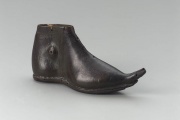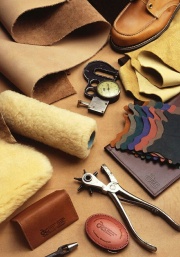Difference between revisions of "Leather"
m (Text replace - "== Authority ==" to "== Sources Checked for Data in Record ==") |
|||
| Line 40: | Line 40: | ||
* Matt Roberts, Don Etherington, ''Bookbinding and the Conservation of Books: a Dictionary of Descriptive Terminology'', U.S. Government Printing Office, Washington DC, 1982 | * Matt Roberts, Don Etherington, ''Bookbinding and the Conservation of Books: a Dictionary of Descriptive Terminology'', U.S. Government Printing Office, Washington DC, 1982 | ||
| − | * ''Encyclopedia Britannica'', http://www.britannica.com Comment: "leather" | + | * ''Encyclopedia Britannica'', http://www.britannica.com Comment: "leather" [Accessed October 18, 2001]. http://www.britannica.com/eb/article?eu=48644>. |
* Art and Architecture Thesaurus Online, http://www.getty.edu/research/tools/vocabulary/aat/, J. Paul Getty Trust, Los Angeles, 2000 | * Art and Architecture Thesaurus Online, http://www.getty.edu/research/tools/vocabulary/aat/, J. Paul Getty Trust, Los Angeles, 2000 | ||
| − | * | + | * WAmerican Leather Chemists Association Glossary at www.leatherchemists.org |
* ''The Dictionary of Art'', Grove's Dictionaries Inc., New York, 1996 Comment: "Leather" | * ''The Dictionary of Art'', Grove's Dictionaries Inc., New York, 1996 Comment: "Leather" | ||
Revision as of 11:52, 12 June 2020
Description
A dehaired animal skin that has been chemically processed to prevent decay while retaining flexibility. The manufacture of leather dates to Neolithic and Bronze age times. Leather is processed by first mechanically cleaning the skin to remove the salt, blood, and dirt, Then the skin is soaked in an alkaline bath which causes the skin to swell and the hairs to loosen so they can be mechanically removed. Once the hair is removed, the skin is soaked in a weak acid solution to reduce the swelling and produce a soft, flexible, smooth-grain material. The skin is then soaked in a solution with a tanning agents. Tanning agents, either vegetable extracts like Tannic acid or mineral salts like chromates, penetrate the skin and react with the protein. Once tanned, the leather can then be dyed and lubricated, or dressed, with hot Soap, Grease, or Wax, to keep the skin supple and water repellent. For some leathers, the surface is finished with brushing, abrading, or glazing. Leathers have been used for clothing, footwear, harnesses, saddlery, bookbinding, upholstery, baggage, purses, and protective coverings.
Synonyms and Related Terms
cuir (Fr.); piel (Esp.); cuero (Esp.);leer (Ned); cabedal (Port.); couro (Port.);
Various types include: aldehyde leather; alum leather; aniline leather; cabretta; chamois; chrome leather; deerskin; Cordoban leather; ecrase leather; glace; Morocco leather; patent leather; parchment; Russian leather; saffian leather; shagreen, skivers; suede; vellum
| Density | 0.86 (dry) |
|---|
Additional Information
"Leather" The Dictionary of Art, Grove's Dictionaries, Inc. New York, 1996.
Additional Images
Sources Checked for Data in Record
- R. J. Gettens, G.L. Stout, Painting Materials, A Short Encyclopaedia, Dover Publications, New York, 1966
- Hermann Kuhn, Conservation and Restoration of Works of Art and Antiquities, Butterworths, London, 1986
- Tom Rowland, Noel Riley, A-Z Guide to Cleaning, Conserving and Repairing Antiques, Constable and Co., Ltd., London, 1981
- Matt Roberts, Don Etherington, Bookbinding and the Conservation of Books: a Dictionary of Descriptive Terminology, U.S. Government Printing Office, Washington DC, 1982
- Encyclopedia Britannica, http://www.britannica.com Comment: "leather" [Accessed October 18, 2001]. http://www.britannica.com/eb/article?eu=48644>.
- Art and Architecture Thesaurus Online, http://www.getty.edu/research/tools/vocabulary/aat/, J. Paul Getty Trust, Los Angeles, 2000
- WAmerican Leather Chemists Association Glossary at www.leatherchemists.org
- The Dictionary of Art, Grove's Dictionaries Inc., New York, 1996 Comment: "Leather"
- CRC Handbook of Chemistry and Physics, Robert Weast (ed.), CRC Press, Boca Raton, Florida, v. 61, 1980 Comment: density=0.86 (dry)



